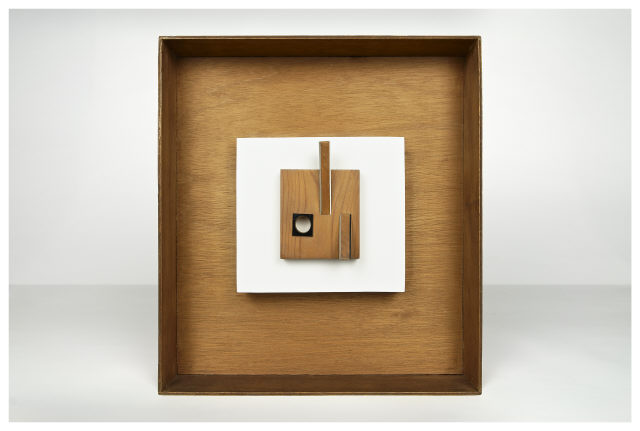
- 1959
- Wood and Metal
- Construction
- Inv. RE8
Mary Martin
Pierced Relief
Martin’s geometry seems to be founded upon the cubist principle of construction. In sculptural compositions created as early as 1951, there is an organic quality to the interlaced geometric patterns worked in relief. These dynamic structures may often be viewed as a projection of a host of natural microcosms. Yet, despite its natural connotations, Martin’s work shares no formalist ties with the biomorphic abstraction one finds in the work of artists such as Ben Nicholson and Barbara Hepworth.
Pierced Relief, though ostensibly a work of pure geometric abstraction, marked by stark simplicity – a principle to which Martin generally seems to adhere – is a lyrical work, filled with intimations of the enigmatic bond between existence and the void. Relationships developing within the work seem to extend into the physical space that surrounds it, becoming a dynamic element of that space and of the viewer’s field of vision. Martin uses wood and industrial materials such as metal as the basic tools of sculptural expression, imposing a set of specific geometric relations upon space.
Her early geometrical work presented a vivid palette, which seems to become increasingly limited in her relief compositions. In Pierced Relief, black and white represent two antithetical elements of existence, negative and positive respectively. The mystical nature of colour and form evokes the metaphysical dynamics that the work of such artists as Malevich, Brancusi and Mondrian was concerned with.
Margarita Kataga
May 2010
| Type | Value | Unit | Section |
| Depth | 9 | cm | |
| Height | 20 | cm | |
| Width | 18,5 | cm |
| Type | Acquisition |
| A Ilha do Tesouro / Treasure Island |
| CAMJAP/FCG |
| Curator: CAMJAP/FCG |
| 7 de Fevereiro de 1997 a 4 de Maio de 1997 Todo o espaço expositivo do CAM - pisos 0, 1 e 01, e Galeria de Exposições Temporárias. |
| Comissários da exposição: Jorge Molder e Rui Sanches. |
